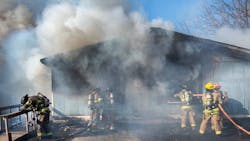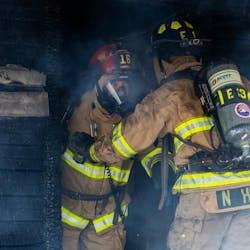Sudden cardiac events are the leading acute cause of line-of-duty deaths, resulting in far more fatalities in most years than burns, asphyxiation, or collapse combined. A large percentage of duty-related cardiac fatalities occur during or shortly after firefighting activities indicating that the work firefighters do can trigger a cardiac event.
Fire service leadership has taken many steps to reduce the burden of cardiovascular events in the firefighting tanks, including advocating that all firefighters should receive an annual medical evaluation by a healthcare provider who understands the physical and psychological demands of the job and the environment in which the work takes place. Resources such as the First Responder Center for Excellence (FRCE) Provider’s Guide for Firefighter Annual Evaluations will assist providers in understanding the risks involved with being a firefighter and offer an example of critical medical tests that they need to undergo. While this is a necessary step, it is insufficient.
For a medical evaluation to be truly effective, information found during the evaluation must be acted upon by the firefighter.
The medical 360
Just like a 360-size-up on the fireground, a cardiovascular evaluation (size-up) during a medical evaluation is only effective if key risks are recognized, effectively communicated, and acted upon.
A fireground size-up can identify life safety risks that indicate that some operations should stop. It also identifies ongoing risks that need to be managed to continue working effectively and safely. As seen in Table 1 below, during a size-up on the fireground, something so significant may be identified by someone reporting to the incident commander (IC), that the IC will decide that interior operations must be halted. This may be temporary, or continue for the duration of the incident.
|
|
Fireground Size-Up |
Cardiovascular Size-Up |
|
Purpose |
Evaluate risk from all sides of the structure/incident |
Evaluate the risk of incapacitating conditions and early disease detection. |
|
Key Factors to Assess |
• Fire • Smoke • Entrapment • Basement • Building Modification
|
Evaluate Modifiable Risk Factors: Blood pressure, lipids, triglycerides, blood glucose, obesity, inactivity Potential Screening for Cardiovascular Disease: Coronary Artery Calcium Scan – to evaluate plaque in coronary arteries Exercise stress test – to assess ischemia induced by exertion Echocardiogram – to assess cardiac enlargement or dysfunction |
|
Communication is critical |
To incident command and from IC to interior crews |
Information from Occupational Health Exam should be shared with: a. Firefighter b. Primary care provider Follow-up tests may be ordered by: a. Occupational health provider b. Primary care physician |
|
Required actions |
Mitigate threats: • Incident Command provides direction. • Firefighter actions
|
Occupational Health Exam identifies the problem. If cleared for duty, ongoing issues that have been identified must be managed (acted upon): • Primary care provider manages care, often through prescribing medication. Sometimes refers to specialists. • Firefighter must 1. Comply with medication or other treatment. 2. Embrace behavioral change |
Similarly, if an incapacitating risk is recognized during a medical evaluation, a firefighter may not be cleared for duty until the condition is corrected. This can occur but it is unusual. And, when it does occur, it is often temporary until a potential issue is ruled out or an identified problem is corrected. Far more commonly, however, the medical exam (size-up) detects issues that may be dangerous if they are not effectively managed.
For example, if hypertension is detected during a medical evaluation, this will seldom prevent a firefighter from being cleared for duty, although it could if it were dangerously high. But it is similar to seeing smoke during a size-up, it indicates that there is a problem that must be addressed. Whether on the fireground or following a medical evaluation, ignoring an issue that has been identified is dangerous — and could be life-altering.
Clear communication among personnel is as important on the fireground as when you are managing health issues.
An occupational health exam is meant to ensure that a firefighter does not have a condition that is “likely” to lead to an incapacitating event within a year. But countless other health issues can be identified during this medical evaluation, and many of these need to be followed up. Importantly, it is not the role of the occupational physician to manage or treat a condition.
So, for the example we used earlier: if elevated blood pressure is found during an occupational medical exam, the evaluating occupational health provider is likely to refer the firefighter to his or her primary care provider to manage or treat hypertension. It is critical to note that in most cases, an occupational provider cannot treat the condition. The fact that they do not treat does not mean everything is okay — it means that treating an ongoing health condition is not in their scope of practice.
Like information that is identified during an on-scene size-up, failing to communicate valuable information from an occupational medical evaluation or to appropriately act upon it renders the evaluation of risk meaningless.
For more information and resources, visit the FRCE at https://firstrespondercenter.org.
About the Author
Dr. Denise Smith
Dr. Denise Smith is a professor at Skidmore College and a research scientist at the Illinois Fire Service Institute (IFSI). She conducts research on the heat stress and cardiovascular strain associated with firefighting, pathoanatomic cause of firefighter fatalities, and strategies to increase performance and decrease cardiovascular events in the fire service.

